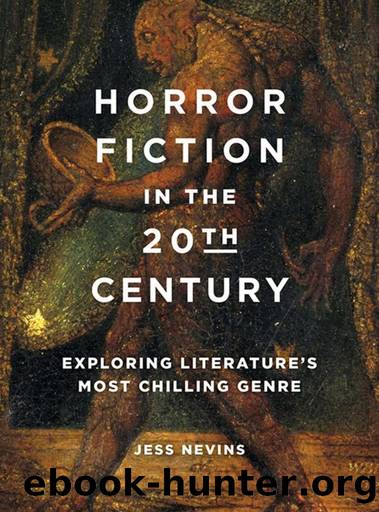Horror Fiction in the 20th Century: Exploring Literature's Most Chilling Genre by Jess Nevins

Author:Jess Nevins [Nevins, Jess]
Language: eng
Format: azw3
Tags: Horror, Nonfiction, History
ISBN: 9781440862069
Publisher: Praeger
Published: 2020-01-07T00:00:00+00:00
Germany
The German dime novels, or heftromane, flourished through the 1950s and provided the German reading audience with cheaply produced, sensationalist genre fiction, including horror. Although the horror was usually of the most unsubtle and elementary sort, quite unlike the classics of prewar German and English horror that the German reading audience was used to, the heftromane was at least something that horror loving Germans could read during the otherwise lean years.
Italy
Dino Buzzati is acclaimed for his horror stories, which are imbued with his existentialism but go beyond that into the surreal and the weird. Critics have compared his work to that of Kafka and Stefan Grabinski and argued for the influence of Italo Calvino and Primo Levi. These critics also charge that Buzzatiâs work lacks the grandiose imagination of Calvino and the profundity borne of the life experience of Levi. But Buzzatiâs work, though undoubtedly influenced by those writers, was uniquely his own. Buzzatiâs stories are fabular, lacking in supernatural elements but filled with weird dreads of no apparent or explicable cause. The horror in them comes from their angst, bleak pessimism, and sense of futility, their paranoia and feeling of impending catastrophe, their contes cruel endings, from the way in which ordinary institutions become menacing and destructive monsters. Buzzatiâs journalistic realism adds to the horror in its matter-of-fact narration. His stories are terse and slickly told, narratively dextrous, emotional in the way of the best contes cruel, and effective in their argument that life is futile and that all dreams of achievement come to nothing in the end.
Tommaso Landolfiâs work was primarily fantastika, much of it horrific. His work, which tends toward the surreal, magical, and grotesque, is usually told in an elegant narrative style whose graceful, complex vocabulary is jarringly at odds with the storiesâ subject matter and Landolfiâs frequent use of nonlinear or fragmented narratives. Though Landolfi frequently used supernatural devices, much of his work is psychological, with Landolfibringing the reader into the mind of either a victim of some incomprehensible ontological transgression or into the mind of someone unbalanced and violent. His horror is modern horror: no Gothics or traditional ghost stories for Landolfi, rather stories that are set in spaceships, that build on the works of earlier horror writers, from Poe to Gogol to Kafka, that incorporate existentialist attitudes toward society. In Landolfiâs stories, horror can never be controlled, conquered, or exorcized; humans are small next to whatever terrorizes them, âabandoned, each on their own in a narrative of fear without resolution.â33
Download
This site does not store any files on its server. We only index and link to content provided by other sites. Please contact the content providers to delete copyright contents if any and email us, we'll remove relevant links or contents immediately.
What's Done in Darkness by Kayla Perrin(25500)
Shot Through the Heart: DI Grace Fisher 2 by Isabelle Grey(18220)
Shot Through the Heart by Mercy Celeste(18160)
The Fifty Shades Trilogy & Grey by E L James(17775)
The 3rd Cycle of the Betrayed Series Collection: Extremely Controversial Historical Thrillers (Betrayed Series Boxed set) by McCray Carolyn(13189)
The Subtle Art of Not Giving a F*ck by Mark Manson(12912)
Scorched Earth by Nick Kyme(11832)
Stepbrother Stories 2 - 21 Taboo Story Collection (Brother Sister Stepbrother Stepsister Taboo Pseudo Incest Family Virgin Creampie Pregnant Forced Pregnancy Breeding) by Roxi Harding(11040)
Drei Generationen auf dem Jakobsweg by Stein Pia(10217)
Suna by Ziefle Pia(10186)
Scythe by Neal Shusterman(9262)
International Relations from the Global South; Worlds of Difference; First Edition by Arlene B. Tickner & Karen Smith(8608)
Successful Proposal Strategies for Small Businesses: Using Knowledge Management ot Win Govenment, Private Sector, and International Contracts 3rd Edition by Robert Frey(8419)
This is Going to Hurt by Adam Kay(7695)
Dirty Filthy Fix: A Fixed Trilogy Novella by Laurelin Paige(6453)
He Loves Me...KNOT by RC Boldt(5804)
How to Make Love to a Negro Without Getting Tired by Dany LaFerrière(5378)
Interdimensional Brothel by F4U(5304)
Thankful For Her by Alexa Riley(5161)
